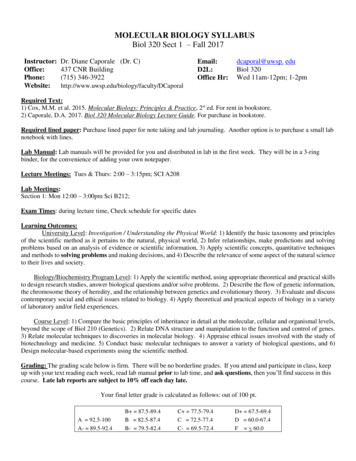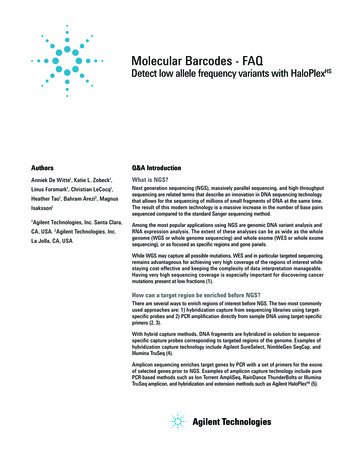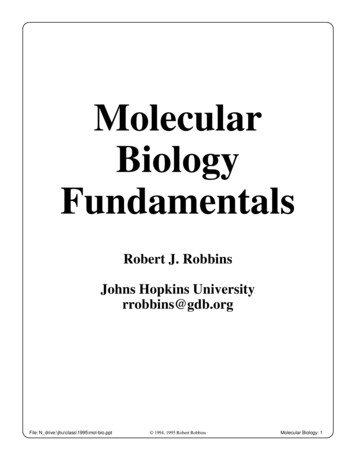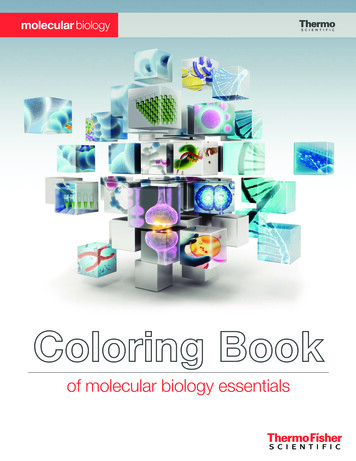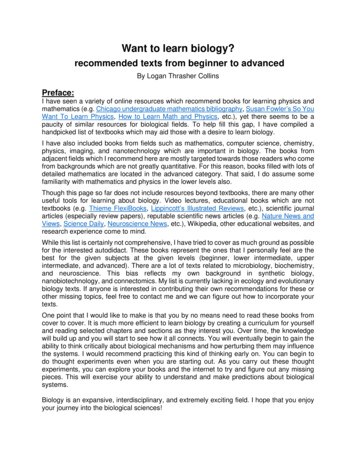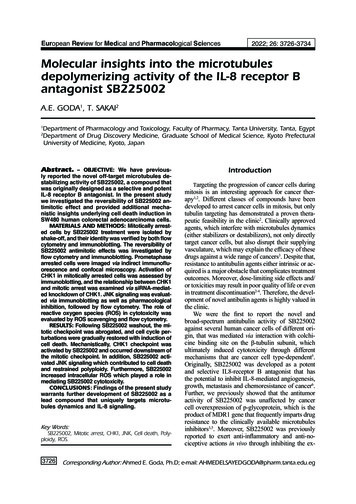
Transcription
European Review for Medical and Pharmacological Sciences2022; 26: 3726-3734Molecular insights into the microtubulesdepolymerizing activity of the IL-8 receptor Bantagonist SB225002A.E. GODA1, T. SAKAI2Department of Pharmacology and Toxicology, Faculty of Pharmacy, Tanta University, Tanta, EgyptDepartment of Drug Discovery Medicine, Graduate School of Medical Science, Kyoto PrefecturalUniversity of Medicine, Kyoto, Japan12Abstract. – OBJECTIVE: We have previous-ly reported the novel off-target microtubules destabilizing activity of SB225002, a compound thatwas originally designed as a selective and potentIL-8 receptor B antagonist. In the present studywe investigated the reversibility of SB225002 antimitotic effect and provided additional mechanistic insights underlying cell death induction inSW480 human colorectal adenocarcinoma cells.MATERIALS AND METHODS: Mitotically arrested cells by SB225002 treatment were isolated byshake-off, and their identity was verified by both flowcytometry and immunoblotting. The reversibility ofSB225002 antimitotic effects was investigated byflow cytometry and immunoblotting. Prometaphasearrested cells were imaged via indirect immunofluorescence and confocal microscopy. Activation ofCHK1 in mitotically arrested cells was assessed byimmunoblotting, and the relationship between CHK1and mitotic arrest was examined via siRNA-mediated knockdown of CHK1. JNK signaling was evaluated via immunoblotting as well as pharmacologicalinhibition, followed by flow cytometry. The role ofreactive oxygen species (ROS) in cytotoxicity wasevaluated by ROS scavenging and flow cytometry.RESULTS: Following SB225002 washout, the mitotic checkpoint was abrogated, and cell cycle perturbations were gradually restored with induction ofcell death. Mechanistically, CHK1 checkpoint wasactivated by SB225002 and occurred downstream ofthe mitotic checkpoint. In addition, SB225002 activated JNK signaling which contributed to cell deathand restrained polyploidy. Furthermore, SB225002increased intracellular ROS which played a role inmediating SB225002 cytotoxicity.CONCLUSIONS: Findings of the present studywarrants further development of SB225002 as alead compound that uniquely targets microtubules dynamics and IL-8 signaling.Key Words:SB225002, Mitotic arrest, CHK1, JNK, Cell death, Polyploidy, ROS.3726IntroductionTargeting the progression of cancer cells duringmitosis is an interesting approach for cancer therapy1,2. Different classes of compounds have beendeveloped to arrest cancer cells in mitosis, but onlytubulin targeting has demonstrated a proven therapeutic feasibility in the clinic2. Clinically approvedagents, which interfere with microtubules dynamics(either stabilizers or destabilizers), not only directlytarget cancer cells, but also disrupt their supplyingvasculature, which may explain the efficacy of thesedrugs against a wide range of cancers3. Despite that,resistance to antitubulin agents either intrinsic or acquired is a major obstacle that complicates treatmentoutcomes. Moreover, dose-limiting side effects and/or toxicities may result in poor quality of life or evenin treatment discontinuation2-4. Therefore, the development of novel antibulin agents is highly valued inthe clinic.We were the first to report the novel andbroad-spectrum antitubulin activity of SB225002against several human cancer cells of different origin, that was mediated via interaction with colchicine binding site on the β-tubulin subunit, whichultimately induced cytotoxicity through differentmechanisms that are cancer cell type-dependent5.Originally, SB225002 was developed as a potentand selective IL8-receptor B antagonist that hasthe potential to inhibit IL-8-mediated angiogenesis,growth, metastasis and chemoresistance of cancer6.Further, we previously showed that the antitumoractivity of SB225002 was unaffected by cancercell overexpression of p-glycoprotein, which is theproduct of MDR1 gene that frequently imparts drugresistance to the clinically available microtubulesinhibitors3,5. Moreover, SB225002 was previouslyreported to exert anti-inflammatory and anti-nociceptive actions in vivo through inhibiting the ex-Corresponding Author: Ahmed E. Goda, Ph.D; e-mail: AHMEDELSAYEDGODA@pharm.tanta.edu.eg
Characterization of SB225002 antitubulin activitypression of iNOS and COX2, along with attenuatingpro-inflammatory cytokines, such as IL-1β, TNFαand keratinocyte-derived chemokines7,8.Given this promising antitubulin potential ofSB225002, the present study was undertaken to shedlights onto the characteristics of SB225002-inducedmitotic arrest and to investigate additional mechanisms underlying its cytotoxicity.Materials and MethodsChemicalsBoth SB225002 and JNK inhibitor SP600125(Selleckchem, Houston, TX, USA) were dissolvedin anhydrous dimethyl sulfoxide (DMSO, Sigma-Aldrich, St. Louis, MO, USA), aliquoted andstored at -80 C. SB225002 aliquots were stored at-80 C for no more than 2 months. Repeated freezethaw cycles of aliquots were avoided. N-acetylcysteine was purchased from Sigma-Aldrich (St. Louis,MO, USA).Cell Line and Culture ConditionsHuman colorectal adenocarcinoma cell lineSW480 (ATCC, Mannassas, VA, USA) was maintained in DMEM (Gibco, Grand Island, NY, USA)and were supplemented with 10% fetal bovine serum (FBS, Hyclone, Logan, UT, USA), L-glutamine(4 mmol/L for DMEM), 100 units/mL penicillin,and 100 µg/mL streptomycin (Gibco, Grand Island,NY, USA). Cell cultures were incubated at 37 C in ahumidified atmosphere of 5% CO2.ImmunoblottingProtein isolation and immunoblotting werecarried out as previously described9. The primaryantibodies used were anti-p-JNK, anti-c-Jun, anti-p-CHK1 ser345, anti-CHK1, anti-Cyclin B1,anti-p-Histone H3, anti-Cdc25c, anti-Securin, anti-b-actin (Cell Signaling Technologies, Beverly,MA, USA); anti-BubR1, (BD Biosciences, SanJose, CA, USA); anti-BcL2 (Dako, Glostrup, Denmark). Secondary antibodies used were HRP-anti-rabbit IgG and HRP-anti-mouse IgG (Cell Signaling Technologies, Beverly, MA, USA).Analysis of Cell Cycle via FluorescenceActivated Cell Sorting (FACS)Cell cycle perturbations were analyzed as previously described9 using FACSCalibur flow cytometerand CellQuest software package (BD Biosciences,San Jose, CA, USA), with exclusion of cell aggregates via FL2W-FL2A gating. A representative dataof 3 independent experiments (with triplicate ineach) is depicted as the mean SEM.Indirect Immunofluorescence and ConfocalMicroscopyImmunocytochemistry of α-tubulin was performed as previously described5, using anti-α-tubulin primary antibody, FITC-conjugated secondaryantibody (Santa Cruz Biotechnology, Santa Cruz,CA, USA) and DNA counterstaining with propidium iodide (Sigma-Aldrich, St. Louis, MO, USA).Olympus FluoView FV1000 confocal microscope(Olympus, Tokyo, Japan) was used for image acquisition and analysis.Knockdown of Gene Expression via SmallInterfering RNA (siRNA)Knockdown of CHEK1 gene (encoding CHK1)and scramble siRNA (LacZ) were carried out usingpreviously reported siRNA sequences10,11 that weresynthesized by Qiagen (Hilden, Germany). Cellswere transfected using HiPerFect transfection reagent(Qiagen, Hilden, Germany) according to the manufacturer’s instructions. Knockdown efficiency was assessed by immunoblotting, and the impact of CHK1knockdown on cell cycle was assessed by FACS.Intracellular ROS AssessmentSW480 cells were pretreated with 10 mM N-acetylcysteine for 1 hr, then co-treated with varying concentrations of SB225002 for 12 hours, then cells wereprocessed for loading of CM-H2DCFDA (Invitrogen,Waltham, MA USA) and intracellular ROS were assessed as previously described9 using FACSCaliburflow cytometer and CellQuest software package (BDBiosciences, San Jose, CA, USA). A representativedata of 3 independent experiments (with triplicate ineach) is depicted as the mean SEM.Statistical AnalysisOne-way analysis of variance (ANOVA), followed by Tukey-Kramer post-hoc test, were carried out using SPSS 22.0 Statistics software package (IBM Corp., Armonk, NY, USA). Differenceswere considered statistically significant at p 0.05.ResultsMitotic Arrest Induction by SB225002in SW480 Cells is Reversibleand is Associated with Cell DeathTo characterize the reversibility of the antimitotic activity of SB225002, SW480 cells were3727
A.E. Goda, T. SakaiTable I. Flow cytometry-based verification of the identity of SB225002-incued mitotic SW480 cells isolated by shake-off procedures relative to SB225002-treated cells without mitotic shake-off application.Cells treated with SB225002 or controlvehicle FACS analysis WITHOUT mitotic shake-offG1SG2MSB225002-treated cells Mitotic shake-off FACS analysis of detached and adherent cellsDMSOSB225002Detached cellsAdherent cells46.1 4.1534.6 2.7719.42 1.8421.2 1.8718.8 1.6760.1 5.892.6 0.233.6 0.393.4 7.3831.6 2.6228.9 2.2539.3 3.03Results are presented as the mean SEM. DMSO: Dimethylsulfoxide control vehicle.treated with SB225002 (650 nM) for 12 hours.The reason why this concentration of SB225002and the exposure time were adopted is that inour previous work the IC50 of SB225002 was approximately 650 nM and mitotic arrest peakedafter 12 hours using the same cell line5. Then,mitotic shake-off was carried out to separate mitotic cells from interphase cells, and the identityof the isolated cells vs. adherent cells was verified by both flow cytometry and immunoblotting. Cell cycle analysis by fluorescence-activated cell sorting (FACS) showed that, followingSB225002 treatment, approximately 93% of theseparated cells were G2/M arrested (Table I),while the remaining adherent cells were distributed in G1, S and G2/M phases (Table I). Theseresults when compared to those obtained withFACS analysis of SB225002-treated cells without shake-off, clearly revealed the enrichmentof G2/M population of the isolated cells (TableI). Moreover, immunoblotting of different mitotic markers showed that the substrates of theanaphase promoting complex cyclin B1 and hyperphosphorylated securin were evidently accumulated in the isolated cells relative to the adherent cells (Figure 1A). Similarly, BubR1 (themitotic checkpoint kinase), Cdc25c (the mitotictrigger), histone H3 and BcL2 were all strongly hyperphosphorylated in the isolated cells incontrast to adherent cells (Figure 1A), indicatingthat the isolated cells were mitotically arrested.Collectively, these results confirmed the efficiency of the applied shake-off procedures in isolating mitotic cells following SB225002 treatment.Next, we assessed the reversibility ofSB225002-induced mitotic arrest using the mitotic cells isolated by shake-off procedures. To thisend, SB225002 treatment was performed for 12hours, followed by mitotic cells separation andre-plating into a fresh culture medium (withoutSB225002), at various time points (2, 4, 8, 16,24 hours), then cells were harvested for cell cy3728cle analysis by flow cytometry, as well as for theassessment of mitotic markers expression by immunoblotting. Results showed that 2 hours afterrelease, about 80% of the cells were in the G1phase, 4% appeared as SubG1 population, andthe remaining were in S and G2/M phases (Figure 1B). At the subsequent time points, there weretime-dependent increments in SubG1 populationalong with a gradual redistribution of cells amongdifferent phases of the cell cycle (Figure 1B). Immunoblotting further supported flow cytometryresults where all the examined mitotic markerswere normalized 2 hours after release suggestiveof a mitotic exit (Figure 1C), and the expressionpattern of the assessed mitotic markers at subsequent time points coincided with the corresponding changes in cell cycle distribution in a timelymanner (Figure 1B, 1C). Taken together, thesefindings suggested that after a brief (12 hours)exposure to SB225002 followed by a washout,the mitotically arrested cells can re-enter the cellcycle and undergo cell death, which indicated thereversibility of SB225002-induced mitotic arrestin SW480 cells.SB225002 Activated CHK1 DNA DamageCheckpoint which Occurred Downstreamof the Mitotic Checkpoint in SW480 CellsWe have previously shown that SB225002triggered a prometaphase arrest and activated thespindle assembly checkpoint (SAC), as a resultof microtubules depolymerization and the resultant chromosomal misalignment5. Accordingly,we investigated whether SB225002 may activateDNA damage checkpoint in mitotically arrestedcells. Confocal microscopy showed the existenceof a fragmented chromosomal DNA in prometaphase arrested SW480 cells, following 12 hoursof SB225002 treatment (Figure 2A). Time-courseimmunoblot analysis of DNA damage checkpoints revealed that CHK1 was phosphorylatedat serine 345 residue by SB225002 (650 nM) as
Characterization of SB225002 antitubulin activityFigure 1. SB225002-triggered mitotic arrest is reversible with induction of cell death in SW480 cells. A, Immunoblottingof mitotic markers in SW480 cells treated with SB225002 (650 nM) for 12 hrs, then subjected to mitotic shake-off. Loadingcontrol: β-Actin. B, Time-course FACS analysis, and C, Time-course immunoblotting of mitotic markers. Both B and C werecarried out on the isolated mitotic SW480 cells after being treated with SB225002 (650 nM) for 12 hrs, then released into freshculture medium for 2, 4, 8, 16, 24 hrs. The small letters a, b, c, d in panel B indicate statistically significant differences from thecorresponding cell cycle population of the 2 hrs time point at p 0.05.early as 1.5 hour, and this phosphorylation peakedafter 12 hours, but declined thereafter (Figure 2B)coinciding with the kinetics of hyperphosphorylation of a prominent mitotic marker securin (Figure2B). On the other hand, CHK2 phosphorylationcould not be detected (data not shown). Further,CHK1 serine 345 phosphorylation occurred ina dose-dependent manner following SB225002treatment for 12 hours (Figure 2C). Importantly,mitotic shake-off that was carried out on SW480cells – treated with SB225002 for 12 hours – andwas followed by immunoblotting, showed thatCHK1 serine 345 phosphorylation was confinedto the isolated mitotic cells, but was undetectablein the adherent interphase cells (Figure 2D). Thesefindings suggested that the activation of CHK1DNA damage checkpoint exclusively occurred inthe mitotically arrested SW480 cells, followingSB225002 treatment.Furthermore, we investigated whether CHK1knockdown may influence mitotic markers expression by immunoblotting. Results showedthat an efficient CHK1 depletion was unable toabrogate SB225002-induced accumulation of cyclin B1 and hyperphosphorylated securin (Figure3A). Similarly, Cdc25c, histone H3 and BcL2 retained their mitotic hyperphosphorylation uponSB225002 treatment and CHK1 knockdown(Figure 3A). Moreover, flow cytometry revealedthat CHK1 knockdown failed to abrogate mitotic arrest, triggered by SB225002 (Figure 3B).Collectively, these findings suggested that theactivation of CHK1 DNA damage checkpoint occurred downstream of the mitotic arrest inducedby SB225002.SB225002 Activated JNK Signalingin SW480 CellsGiven that microtubules inhibitors can activate p38MAPK and/or JNK12, and that our previous findings showed the activation of p38MAPKsignaling by SB2250025, we investigated whetherSB225002 may increase the phosphorylation ofJNK in SW480 cells. Immunoblotting revealedthat SB225002 dose-dependently upregulated JNK phosphorylation, following 12 hours oftreatment (Figure 4A). Further, treatment withSB225002 brought about a dose-dependent upregulation of JNK downstream target c-Jun (Figure 4A). These findings indicated that JNK signaling was activated by SB225002 in SW480 cells.To gain insights into the functional consequences of JNK activation by SB225002, we3729
A.E. Goda, T. SakaiFigure 2. Activation of CHK1 DNA damage checkpoint by SB225002 in SW480 cells. A, Confocal microscopy of tubulinimmunocytochemistry in SW480 cells treated with SB225002 (650 nM for 12 hrs). Green: tubulin, Red: DNA. Arrows indicate fragmented misaligned DNA. Scale bar 10 μm. B, Time-course immunoblotting of phosphorylated CHK1 and securin inSW480 cells treated with SB225002 (650 nM). C, Immunoblotting of phosphorylated CHK1 in SW480 cells treated with different concentrations of SB225002 for 12 hrs. Loading control: β-Actin. D, Immunoblotting of phosphorylated CHK1 in isolatedmitotic vs. adherent SW480 cells treated with SB225002 (650 nM) for 12 hrs. Loading control: β-Actin.challenged SW480 cells with a well-known JNKinhibitor, prior to SB225002 treatment and immunoblotting was used to validate the efficien-cy of JNK signaling inhibition. Results revealeda marked abrogation of c-Jun upregulation bySB225002 (Figure 4B). Next, FACS analysis ofFigure 3. SB225002-induced CHK1 DNA damage checkpoint occurred downstream of the mitotic checkpoint in SW480 cells.A, Immunoblotting of the expression of mitotic markers in SW480 cells upon knockdown of CHK1 followed by treatment withSB225002 (650 nM) for 12 hrs. Loading control: β-Actin. B, FACS analysis of SW480 cells following CHK1 knockdown andSB225002 treatment (650 nM, 12 hrs).3730
Characterization of SB225002 antitubulin activityFigure 4. SB225002 activated JNK signaling in SW480 cells. A, Immunoblotting of phosphorylated JNK and its downstreamtarget c-Jun in SW480 cells treated with different concentrations of SB225002 for 12 hrs. Loading control: β-Actin. B, Immunoblotting of c-Jun in SW480 cells pre-treated with JNK inhibitor SP600125 (10 µM) for 1 hr then co-treated with SB225002 (650nM) for 12 hrs. Loading control: β-Actin.SW480 cells treated with SB225002 in the presence or absence of the JNK inhibitor showedthat SB225002-induced SubG1 population wassignificantly inhibited by JNK inhibitor pretreatment, while polyploid cells were remarkably anddose-dependently increased by SB225002/JNKinhibitor co-treatment (Table II). These findingssuggested that following SB225002 treatment,JNK activation contributed to cell death and restrained polyploid cell formation.Intracellular ROS Contributedto SB225002-Induced Cell DeathGiven that mitotically arrested cells wereshown to generate excessive intracellular ROSwhich could mediate cell death13, we investigatedtheir potential role in SB225002 cytotoxicity. Flowcytometry analysis of intracellular ROS revealedthat their levels were dose-dependently elevatedby SB225002 treatment (Table III). Moreover,pretreatment with N-acetylcysteine efficientlyscavenged SB225002-induced intracellular ROSaccumulation (Table III). Next, we investigatedthe effect of N-acetylcysteine pretreatment onSB225002-induced cell death by FACS analysis.Results showed that ROS scavenging significantly abrogated SB225002-induced SubG1 population and largely normalized different phases of thecell cycle (Table IV). These findings suggestedthat ROS contributed, at least in part, to the cytotoxicity induction by SB225002.DiscussionMicrotubules have been established as a validtarget in cancer treatment, driving the continualinterest in the introduction of novel antitubulinagents with enhanced efficacies and/or reducedside effects3,4.The reversibility of tubulin targeting is usually associated with a better tolerability and lowerTable II. Flow cytometry analysis of the influence of JNK inhibitor pre-treatment on SB225002-induced cell cycle perturbationsand cell death of SW480 cells.SubG1G1 JNKiDMSOSB350SB500SB650SB800SB9501.5 0.145.1 0.1814.9 0.6319.3 1.0121.4 1.5224.5 2.331.8 0.161.7 0.35*5.8 0.46*8.1 0.62*11.1 0.79*16.4 1.45*S JNKi57.2 5.1553.1 4.7839.8 3.5425.3 2.1315.7 1.2211.1 0.9654.2 4.7245.6 3.71*19.1 1.53*15.2 1.16*11.1 0.79*8.2 0.7*G2/M JNKi19.7 1.7716.5 1.6612.1 1.2913.1 1.311.1 0.878.5 0.8120.9 1.8814.8 1.210.6 1.18.8 0.67*8.2 0.58*5.8 0.65 JNKi18.2 1.4421.1 1.7924.6 2.2126.5 2.7423.7 2.3220.1 1.71Polyploid JNKi19.8 1.8 2.7 0.24 3.2 0.2724.8 2.1* 3.8 0.33 11.9 1.01*30.5 2.4* 7.8 0.68 33.1 2.65*25.2 1.92 15.4 1.17 42.2 3.63*20.9 1.48 27.4 1.95 47.9 4.55*18.8 1.79 34.8 2.69 49.9 3.24*Results are presented as the mean SEM. Asterisk indicates a statistically significant difference at p 0.5 of JNK inhibitor/SB225002co-treated cells versus SB225002-only treatment. SB: SB225002; JNKi: JNK inhibitor; DMSO: Dimethylsulfoxide control vehicle.3731
A.E. Goda, T. SakaiTable III. Investigating the effect of SB225002 on intracellular ROS generation by flow cytometry in SW480 cells (inthe presence or absence of N-acetylcysteine pre-treatment).Intracellular ROS[Median Fluorescence Intensity] NACDMSOSB350SB500SB650SB800SB9507.5 0.759.5 0.6914.2 1.416.3 1.218.4 1.319.9 1.47.2 0.717.5 0.628.4 0.81*9.8 0.79*10.6 0.92*11.4 1.1*Results are presented as the mean SEM. Asterisk indicates astatistically significant difference at p 0.5 of N-acetylcysteine/SB225002 co-treated cells versus SB225002-only treatment. SB:SB225002; NAC: N-acetylcysteine; DMSO: Dimethylsulfoxidecontrol vehiclegrade dose-limiting side effects such as myelosuppression or peripheral neuropathy which arecommonly observed with the clinically availablemicrotubules inhibitors4,14. In the present study,we demonstrated that the antimitotic activity ofSB225002 is reversible, which may be seen as apotential therapeutic merit for this compound.Pharmacologic induction of a prolonged mitotic arrest has been shown to result in DNA breaksin mitotic chromosomes and activation of DNAdamage checkpoints which preceded cellsdeath15. Our results demonstrated the existenceof chromosomal DNA breaks in prometaphasearrested SW480 cells, and the increased serine345 phosphorylation of CHK1 DNA damagecheckpoint specifically in mitotic cells following SB225002 treatment. Similarly, phosphorylation of CHK1 at serine 345 was previouslyshown to occur at DNA damage foci in stressedcells undergoing mitosis, and phosphorylationat this residue is a critical regulator of CHK1kinase activity16-18.Previous reports have suggested that modulation of CHK1 expression and/or phosphorylationcan either trigger the spindle assembly checkpoint (SAC) or may occur as a downstream eventof SAC activation19,20. Further, the role of CHK1during mitotic arrest varies depending on the typeof the antitubulin agent where CHK1 activity wasrequired for SAC activation and mitotic arrest induction by microtubules stabilizers20. ConverselyCHK1 was dispensable for the antimitotic activity of microtubules depolymerizes20. Our findingshave shown that CHK1 activation by SB225002is a downstream event of mitotic arrest induction. Importantly, the knockdown of CHK1 didnot affect the accumulation of mitotic markersor cell cycle arrest at the M-phase, which furthersupported our previously reported mechanism ofSB225002 as a microtubule depolymerizer5.Microtubules inhibiting agents have been shownto robustly induce JNK phosphorylation in humancancer cells21,22, and JNK activation has been shownto link prolonged mitotic arrest to cell death23. Furthermore, the contributions of JNK toward mitoticprogression through anaphase and protection againstaneuploidy have previously been suggested wherethe inhibition of JNK activity could inhibit chromosome segregation during anaphase and inducedpolyploidy24,25. Polyploid cancer cells, which arecommonly formed due to the prolonged activation of mitotic checkpoint, have a number of criteria such as: expression of cancer stem-like cellmarkers, resistance to treatment, protection againsthost immune system, and the capacity to undergode-polyploidization to re-initiate tumor growth1,26,27.Therefore, it may be concluded that the activationTable IV. Flow cytometry analysis of the impact of SB225002-induced ROS generation on cell cycle perturbations and celldeath of SW480 cells.SubG1 NACDMSOSB350SB500SB650SB800SB950G1S NACG2/M NAC1.8 0.151.9 0.11 58.8 5.77 58.9 5.3 17.9 1.8 18.2 1.5 17.7 1.96.7 0.64.4 0.33 54.2 4.88 56.9 5.54 14.1 1.3 15.9 1.6 20.2 1.816.3 1.74 8.2 0.66* 40.6 3.95 53.2 4.3* 11.2 1.1 14.2 1.2* 25.1 1.921.8 2.14 11.8 1.06* 24.1 2.1 46.1 4.2* 12.3 0.93 13.9 1.3 27.8 1.723.4 2.28 12.8 1.11* 17.5 1.85 40.9 3.6* 9.1 0.82 11.8 1.1* 26.1 1.825.7 1.52 12.6 1.31* 15.1 1.1 38.3 2.9* 6.7 0.26 9.2 0.65* 21.8 1.5 NACPolyploid NAC18.3 1.6 2.9 0.25 2.3 0.2118.6 1.7 4.2 0.38 3.2 0.2620.3 1.5* 6.4 0.58 3.6 .032*23.1 1.6* 13.5 0.94 4.2 0.42*22.5 1.7* 23.4 1.47 8.2 0.71*22.9 1.5 30.9 1.88 12.3 0.93*Results are presented as the mean SEM. Asterisk indicates a statistically significant difference at p 0.5 of N-acetylcysteine/SB225002co-treated cells versus SB225002-only treatment. SB: SB225002; NAC: N-acetylcysteine; DMSO: Dimethylsulfoxide control vehicle.3732
Characterization of SB225002 antitubulin activityof JNK signaling by SB225002 in the current studymay have two important consequences: contributingto cell death induction and curbing polyploidy, sinceco-treatment of SW480 with a selective JNK inhibitor, followed by SB225002, significantly promotedpolyploidy and abrogated cell death.The activation of both JNK and p38MAPK bySB225002 treatment in the current study and in ourprevious work5 suggested the stressful nature of themitotic arrest triggered by SB225002, which wasfurther supported by its potential to induce ROSgeneration demonstrated in the present study. Likewise, prolonged mitotic arrest induction has previously been shown to exacerbate ROS generation13.Recently, mitochondrial dysfunction was shown tooccur during mitotic arrest caused by microtubulesinhibiting agents, resulting in oxidative stress thatcontributed to the antitumor activity of chemotherapeutics that target the mitotic phase28.ConclusionsIn summary, the molecular mechanisms, and thedistinctive properties of SB225002 described thus farprovided a strong rationale for further development ofSB225002 as a lead antitumor agent that uniquely targets microtubules dynamics and IL-8 signaling.Authors’ ContributionGoda AE: Project conceptualization. Methodology, datacuration, and analysis. Writing- draft and editing. Writingfinal review and approval. Sakai T: Methodology, data curation, and analysis. Writing- final review and approval.Conflict of InterestThe authors declare no known competing financial interestsor personal relationships that may have influenced this paper in whole or in part.Funding receivedNone.References1) Dalton WB, Yang VW. Role of prolonged mitoticcheckpoint activation in the formation and treatment of cancer. Future Oncol 2009; 5: 1363-1370.2) Henriques AC, Ribeiro D, Pedrosa J, Sarmento B,Silva PMA, Bousbaa H. Mitosis inhibitors in anticancer therapy: When blocking the exit becomes asolution. Cancer Lett 2019; 440-441: 64-81.3) Bates D, Eastman A. Microtubule destabilisingagents: far more than just antimitotic anticancerdrugs. Br J Clin Pharmacol 2017; 83: 255-268.4) McLoughlin EC, O’Boyle NM. Colchicine-BindingSite Inhibitors from Chemistry to Clinic: A Review.Pharmaceuticals (Basel) 2020; 13: 8.5) Goda AE, Koyama M, Sowa Y, Elokely KM, YoshidaT, Kim BY, Sakai T. Molecular mechanisms of theantitumor activity of SB225002: a novel microtubuleinhibitor. Biochem Pharmacol 2013; 85: 1741-1752.6) Alfaro C, Sanmamed MF, Rodríguez-Ruiz ME, Teijeira Á, Oñate C, González Á, Ponz M, Schalper KA, Pérez-Gracia JL, Melero I. Interleukin-8in cancer pathogenesis, treatment and follow-up.Cancer Treat Rev 2017; 60: 24-31.7) Bento AF, Leite DF, Claudino RF, Hara DB, Leal PC,Calixto JB. The selective nonpeptide CXCR2 antagonist SB225002 ameliorates acute experimentalcolitis in mice. J Leukoc Biol 2008; 84: 1213-1221.8) Manjavachi MN, Quintão NL, Campos MM, Deschamps IK, Yunes RA, Nunes RJ, Leal PC, CalixtoJB. The effects of the selective and non-peptideCXCR2 receptor antagonist SB225002 on acuteand long-lasting models of nociception in mice.Eur J Pain 2010; 14: 23-31.9) Goda AE, Erikson RL, Sakai T, Ahn JS, Kim BY.Preclinical evaluation of bortezomib/dipyridamolenovel combination as a potential therapeutic modality for hematologic malignancies. Mol Oncol2015; 9: 309-322.10) Ye F, Yang Z, Liu Y, Gong D, Ji T, Wang J, Xi B,Zhou J, Ma D, Gao Q. Co-abrogation of Chk1 andChk2 by potent oncolytic adenovirus potentiatesthe antitumor efficacy of cisplatin or irradiation.Cancer Gene Ther 2014; 21: 209-217.11) Rousseau J, Gioia R, Layrolle P, Lieubeau B, Heymann D, Rossi A, Marini JC, Trichet V, Forlino A.Allele-specific Col1a1 silencing reduces mutantcollagen in fibroblasts from Brtl mouse, a modelfor classical osteogenesis imperfecta. Eur J HumGenet 2014; 22: 667-674.12) Oren A, Herschkovitz A, Ben-Dror I, HoldengreberV, Ben-Shaul Y, Seger R, Vardimon L. The cytoskeletal network controls c-Jun expression andglucocorticoid receptor transcriptional activity inan antagonistic and cell-type-specific manner. MolCell Biol 1999; 19: 1742-1750.13) Patterson JC, Joughin BA, van de Kooij B, Lim DC,Lauffenburger DA, Yaffe MB. ROS and OxidativeStress Are Elevated in Mitosis during Asynchronous Cell Cycle Progression and Are Exacerbatedby Mitotic Arrest. Cell Syst 2019; 8: 163-167.e2.14) Niu L, Yang J, Yan W, Yu Y, Zheng Y, Ye H, ChenQ, Chen L. Reversible binding of the anticancerdrug KXO1 (tirbanibulin) to the colchicine-bindingsite of β-tubulin explains KXO1’s low clinical toxicity. J Biol Chem 2019; 294: 18099-18108.3733
A.E. Goda, T. Sakai15) Dalton WB, Nandan MO, Moore RT, Yang VW. Humancancer cells commonly acquire DNA damage duringmitotic arrest. Cancer Res 2007; 67: 11487-11492.16) Capasso H, Palermo C, Wan S, Rao H, John UP,O’Connell MJ, Walworth NC. Phosphorylation activates Chk1 and is required for checkpoint-mediated cell cycle arrest. J Cell Sci 2002; 115: 45554564.17) Goto H, Kasahara K, Inagaki M. Novel insightsinto Chk1 regulation by phosphorylation. CellStruct Funct 2015; 40: 43-50.18) Wilsker D, Bunz F. Chk1 phosphorylation duringmitosis: a new role for a master regulator. Cell Cycle 2009; 8: 1161-1163.19) Tang J, Erikson RL, Liu X. Checkpoint kinase 1(Chk1) is required for mitotic progression throughnegative regulation of polo-like kinase 1 (Plk1).Proc Natl Acad Sci U S A 2006; 103: 11964-11969.20) Zachos G, Black EJ, Walker M, Scott MT
sessed as previously described9 using FACSCalibur flow cytometer and CellQuest software package (BD Biosciences, San Jose, CA, USA). A representative data of 3 independent experiments (with triplicate in each) is depicted as the mean SEM. Statistical Analysis One-way analysis of variance (ANOVA), fol-lowed by Tukey-Kramer post-hoc test, were car-



